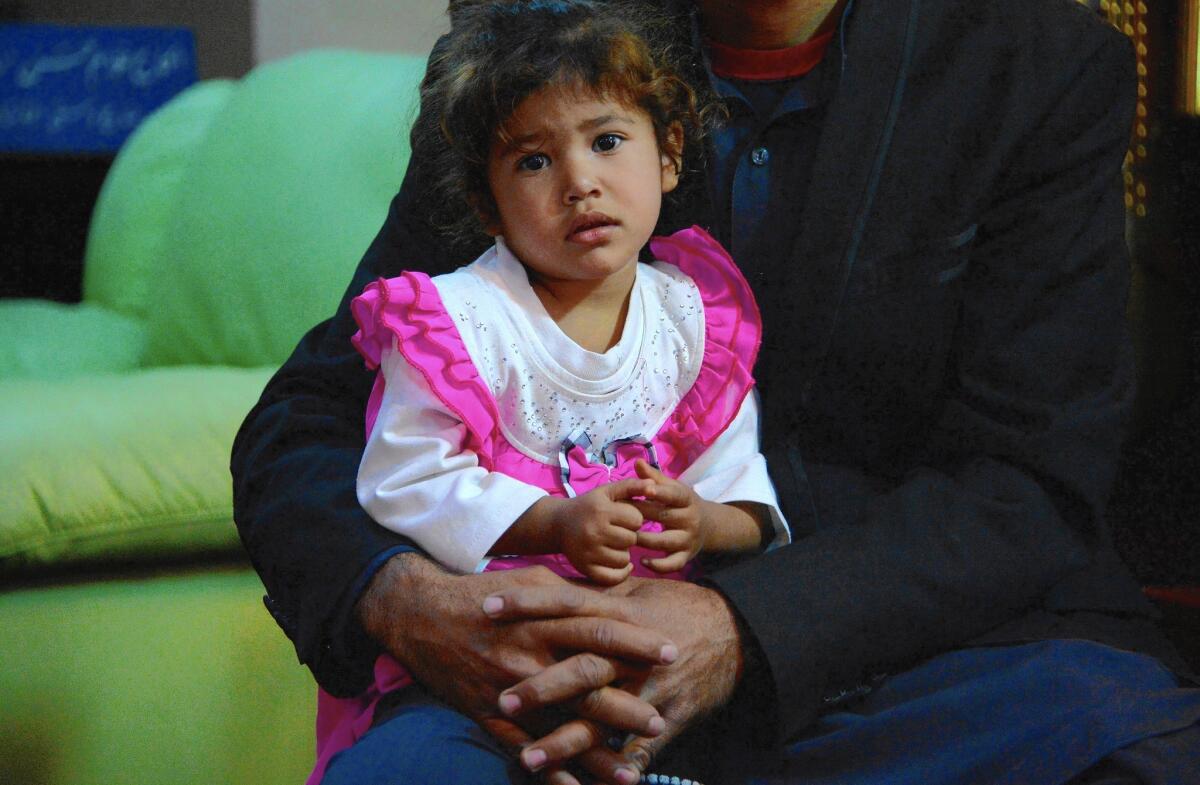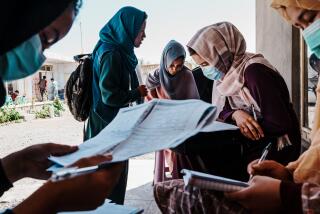For displaced Afghans, extended U.S. troop presence offers little solace

An Afghan father and child displaced by fighting wait for temporary shelter in Kabul.
reporting from Kabul, Afghanistan — For years, residents of Kapisa province have been caught in the crossfire between the Taliban and American-assisted Afghan government forces.
But in recent months, the fighting has intensified to the point where many in the northeastern region of pomegranate farmers and livestock herders have felt compelled to relocate to makeshift settlements in Kabul, the Afghan capital.
“The Taliban will say ‘you are with the government’ and the security forces will say ‘you are with the Taliban,’ but really, we’re just trying to live,” said Agha Jan, a leader of a temporary camp in the capital’s Arzan Qimat neighborhood, where additional families from Kapisa’s Tagab district arrive each week.
Yet when President Obama recently announced that he would keep at least 5,500 U.S. troops in Afghanistan beyond the previously announced 2016 withdrawal, it came as little solace to many of those who have fled the fighting.
“I wish instead they would just provide us with weapons to protect ourselves,” said Agha Jan. “Either the government needs to leave, or the Taliban — as long as both are there, Tagab won’t see peace.”
A few miles down the road in the Pul-i-Charkhi neighborhood, members of a community of 150 internally displaced families from the eastern province of Nangarhar express a similar sense of weariness that has overwhelmed any positive feelings about Obama’s announcement. Without additional fiscal support from America, some said, a continued U.S. presence in Afghanistan will bring little security.
Renewed financial investment must accompany any remaining foreign troop presence, said Azim Gol, 35, who left his native Momand Dara district five months ago. With Afghanistan’s double-digit unemployment rate, which some sources put as high as 35%, the government must compete with armed opposition for loyalty, he said.
What’s more, he added, the need has been heightened with the emergence of fighters claiming ties to Islamic State militants in the Middle East.
“All of these groups, including ISIS, are promising people hundreds of dollars a month to fight alongside them,” he said, using an acronym for the militant group.
The U.S., he said, is “just another player in the conflict — we need solutions.”
At this point, many here say, there are just too many forces at play and not enough positive action.
Like many Afghans, the displaced Tagabis and Nangarharis in camps believe neighboring Pakistan is fueling unrest. Azim Gol said the fighters who say they are affiliated with Islamic State speak in Pakistani-accented Pashto and exhibited mannerisms mostly seen in Pakistani areas.
“We know the Taliban, they are from our own areas, but these men were different,” he said. “They didn’t look like us, they had long hair, drove cars we had never seen before. Even their weapons were of the highest caliber.”
Abdullah Abdullah, Afghanistan’s chief executive, has called for more international pressure on Islamabad.
“The presence of terrorist sanctuaries and support networks in Pakistan continue to cause trouble inside Afghanistan,” he said at the United Nations.
Azim Gol said the foreign fighters began requesting their financial support.
“They knocked on our doors demanding we either join in their fight or give them money,” he said.
Initially, the families were left alone, with the militants saying their beef was with the Taliban, not the people.
“They said the Taliban do not abide by sharia [Islamic law].”
But that changed when they succeeded in ridding the area of the Taliban, Azim Gol said.
Most troubling, he said, was the group’s announcement of sexual jihad.
“They asked for women, even the widows, to be handed over to their fighters; we are simple, religious people, how could we ever allow our women to go with foreign men,” said Shokor, another Momand Dara native.
“We said we must consult with our elders and get back to them,” said Azim Gol. “As soon as they left, we fled under the cover of night.”
Those who remain in Nangarhar are either helping the militants for financial reasons or are essentially prisoners in their homes, displaced residents say.
For Naim Faraidoon, 25, of Tagab district, the tipping point was the increased fighting between the Taliban and government forces.
Though his area of Kapisa province had long been considered one of the nation’s least secure areas, Faraidoon said the fighting last year reached unbearable heights.
“Every day bullets would fly from both sides and we were caught in the middle,” he said.
Tagab is nestled between narrow mountain passes and its geography only worsened the effects of the fighting as the armed opposition and government forces battle for control.
“There is nowhere to run, everywhere you look there are mountains,” Faraidoon said of the close-quarters fighting.
Left with nothing, the families have fled, with only discarded tarpaulins for shelter from the elements.
Latifi is a special correspondent.
ALSO:
Russian tourist jet’s crash in Egypt leaves 224 dead
Just out of college and earning $81,000? Must be a CSU Maritime grad
Pharmacist at center of Valeant scandal accuses drugmaker of ‘massive fraud’
More to Read
Sign up for Essential California
The most important California stories and recommendations in your inbox every morning.
You may occasionally receive promotional content from the Los Angeles Times.










